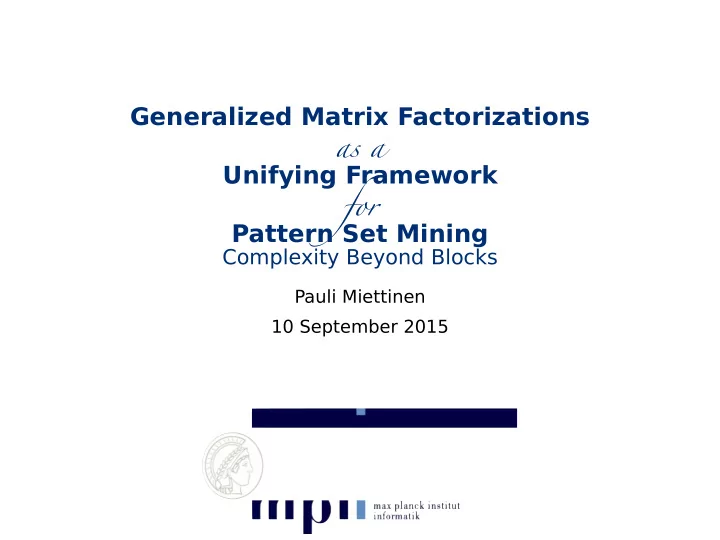

Generalized Matrix Factorizations as a Unifying Framework for Pattern Set Mining Complexity Beyond Blocks Pauli Miettinen 10 September 2015
Community detection A B C ( ) 1 1 1 0 1 A 2 1 1 1 0 1 1 3 A B C B ( ) ( ) 2 1 1 0 1 1 0 o 1 1 = 2 0 1 1 C 0 1 3 3
Rank-1 matrices • (Bi-)cliques are rank-1 submatrices • Collection of rank-1 submatrices summarizes the graph using its cliques • Matrix factorizations express the (complex) input as a sum of rank-1 matrices • AB = � 1 b T 1 + � 2 b T 2 + · · · + � k b T k • Matrix factorizations summarize complex data using simple patterns
Beyond blocks • Cliques are not the only (graph) patterns • Biclique cores, stars, chains • Koutra et al., SDM ’14. • Nested graphs • e.g. Junttila ’11, Kötter et al., WWW ’15 • Hyperbolic communities 600 500 400 • Araujo et al., ECML PKDD ’14 300 200 100 0
Limitations of matrix factorization • The matrix-factorization language is useful • Recycle ideas, approaches, and results • But the other patterns are not rank-1 matrices • It is not easy to express a collection of nested matrices as a matrix factorization
Generalized outer products • Rank-1 matrix = outer product of two vectors • A = xy T • Define generalized outer product o ( � , y , θ ) ∈ R n × m Vectors Parameters • o ( � , y , � ) � j = � � y j or 0
Example: biclique core 0 0 1 1 1 1 1 0 0 1 1 1 = , [ 1 1 1 1 1 ] , { 1 , 2 } o 1 1 1 0 0 0 1 1 1 0 0 0 1 1 1 0 0 0 Rows that belong The core to the pattern Columns that belong to the pattern
Example: nested matrix 1 1 1 1 1 0 1 1 1 1 Step function 1 1 0 0 0 1 1 = 1 , [ 1 1 1 1 1 ] , [ 1 2 2 5 6 ] o 0 0 0 0 0 0 1 0 0 0 1 1 1 0 0 0 0 1
Generalized decompositions • Recall, X ≈ AB = � 1 b T 1 + � 2 b T 2 + · · · + � k b T k is a decomposition of X • The generalized decomposition of X is F � = o ( � � , y � , � � ) X ≈ F 1 Å F 2 Å · · · Å F k , • ⊞ is the addition in the underlying algebra • sum, AND, OR, XOR, …
o -induced rank • The smallest k s.t. X = F 1 ⊞ … ⊞ F k is the o -induced rank of X • Analogous to the standard (Schein) rank • Can be infinite if the matrix cannot be expressed (exactly) with that kind of outer products • If the outer product can generate a matrix that has exactly one nonzero at arbitrary position, it’s induced rank is always bounded
Decomposability • Outer product o is decomposable (to f ) if, for some f , o ( � , y , � ) � j = ƒ ( � � , y j , � , j, � ) • Then we have k Å � � j = ƒ ( � �� , y � j , � , j, � ) � = 1 as in standard matrix multiplication
Nice work, but … why? • So, we can express complex patterns using some weird functions • What’s the advantage? • Using the common language, it’s easy to see how some results (and techniques) can be generalized as well
How hard can it be… • …to find the maximum-circumference pattern? • I.e. given A , find x , y , and θ s.t. o ( x , y , θ ) ∈ A and you maximize | x | + | y | • If o is hereditary and the pattern can have infinitely many distinct rows and columns, NP-hard • If there’s only fixed number of distinct rows or columns, the problem is in P • If x = y is required, then it’s almost always NP-hard
How hard can it be… • …to select the smallest subset that gives an exact summarization? • I.e. given a set S = { F i : rank( F i ) = 1}, ⊞ F ∈ S F = X , find the the smallest C ⊆ S s.t. ⊞ F ∈ C F = X • NP-hard for ⊞ ∈ {AND, OR, XOR} • hard to approximate within ln( n ) for OR and within superpolylogarithmic for XOR
How hard can it be… • …to compute the rank? • Well, that depends… (on the underlying algebra) • Doesn’t depend (only) on the outer product • E.g. normal outer product is NP-hard for OR but in P for XOR
How hard can it be… • …to find the decomposition of fixed size that minimizes the error? • NP-hard if computing the rank is • NP-hard to approximate to within superpolylogarithmic factors for OR and XOR
Conclusions • Matrix factorizations are sort-of mixture models • Present complex data as an aggregate of simpler parts • Generalized outer products let us represent more than just cliques as ”rank-1” matrices • And allow to generalize many results from cliques
Future • More work is needed to see what is the correct level of generality for the outer products • Results for numerical data? • Framework with no users isn’t very useful… Ti ank Y ov ! Qu et tions?
Recommend
More recommend